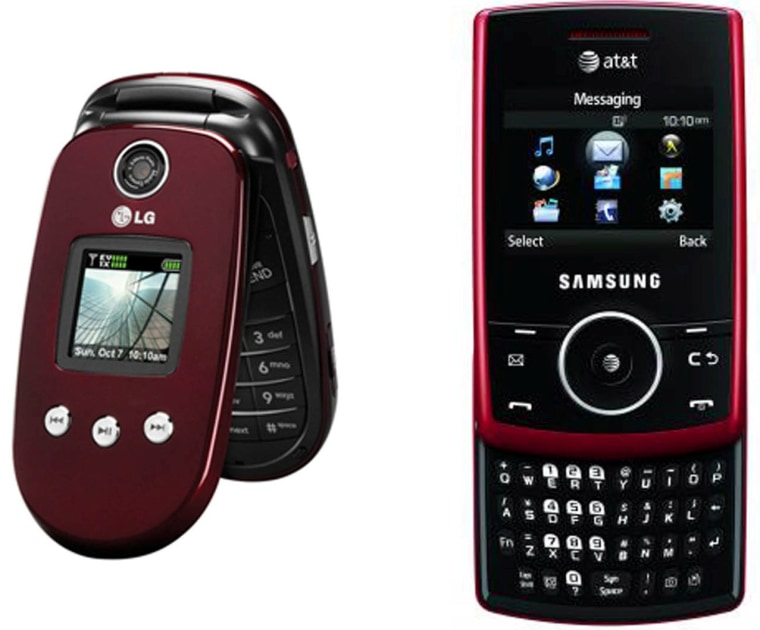The venerable flip phone remains the most popular shape for a cell in the United States, but its lead is being eroded by a newer generation of phones with slide-out keyboards as well as “slate” phones like the iPhone.
And “black is the new black” when it comes to color preference for phones, according to Strategy Analytics, which surveyed more than 2,800 wireless device users in the United States, as well as in Britain, France, Germany, Italy, Spain and Sweden, about what color and “form factor” they want their next phones to be.
The findings mirror the marketplace, which has been moving to a series of largely look-alike black phones, many of which have both touch screens and QWERTY keyboards for e-mail and Web surfing, and are dubbed “smartphones.”
The research firm’s 2008 survey, released this month, compared results from a poll done a year before Apple’s iPhone went on the market in 2007. The iPhone’s “slate,” or “slab” style, with almost the entire entire front of the device as a touch screen, was fairly rare at the time, and resulted in a slew of imitators.
“Two years ago, the slate phone didn’t exist as a category,” said Chris Schreiner, senior analyst for Strategy Analytics.
In 2006 in the United States, 80 percent of respondents said they would consider buying a flip, or clamshell device, compared to 64 percent in 2008.
“The decline comes in part from an interest in some of the new phone form factors, like the slider phone, with a slide-out QWERTY keyboard, and the slate, which is basically the iPhone form factor,” he said.
Candy bar style less favored
While the iPhone and similar touch screen phones have been popular, there are many consumers who are reluctant to go the touch screen route. In the United States, nearly a quarter of those polled said “they would definitely not choose” a slate-style phone for their next device, according to the report.
But the least popular shape is the one-piece, candy-bar style phone, which has a small display on the top half of the phone, with a 12-key dial pad on the bottom half. Only a “frosty” 17 percent said that they would consider a candy-bar phone for their next device, compared to 29 percent in 2006, Strategy Analytics said.
Most phone manufacturers make every kind of device shape in order to appeal to as many customers as possible. Research In Motion, maker of the BlackBerry, the leading smartphone, last year added its first flip phone, as well as its first all-touch screen device, the BlackBerry Storm, to its lineup.
Clamshell phones remain popular with two-thirds of consumers 35 and older because it’s a “basic, voice-centric, just-use-the-phone type of device,” said Schreiner. “They also tend to like it more than a phone with an outer display, or touch screen, because they feel it’s not going to break as easily.”
Fifty percent of those under age 25 favor flips, compared to 84 percent in 2006, Strategy Analytics found.
The clamshell-style phone was extremely popular in the 1990s, when cell phones became more mainstream. Motorola’s StarTAC flip phone, released in the mid-1990s, was an enormous success, as was the company’s sleeker subsequent flip phone, the RAZR.
It remains one of the best-selling phones, although it is losing ground to slab-style phones like the iPhone.
Appeal of basic black
When it comes to cell color, consumers are moving from silver to basic black, both in the U.S. and in Western Europe.
“It used to be that black and silver were pretty equal, but now in the United States, 43 percent of consumers want their next device to be black,” said Schreiner. “The next highest color was silver, favored by 15 percent.”
Schreiner doesn’t attribute black’s popularity to the iPhone. “I’d say it’s a very bold color that people just seem to be more attracted to. Silver was more so when devices like (Motorola’s) RAZR were popular.”
Third on the color wheel: blue, favored by 11 percent, he said, compared to 16 percent in 2006.
Pink, purple, red, green, gold and white were also popular, especially among survey respondents under age 25, with only half of them saying they’d go for black or silver in their next device.
Strategy Analytics also looked at color choices by wireless carrier. Among the findings:
- 51 percent of AT&T respondents say they prefer black for their next device, compared to 40 percent of Verizon Wireless and Sprint customers
- Blue is as popular as silver for Sprint customers, “with 15 percent claiming it would be their first choice of color for their next device.”
- Pink is the third most-preferred color for survey respondents who are Verizon Wireless customers.
